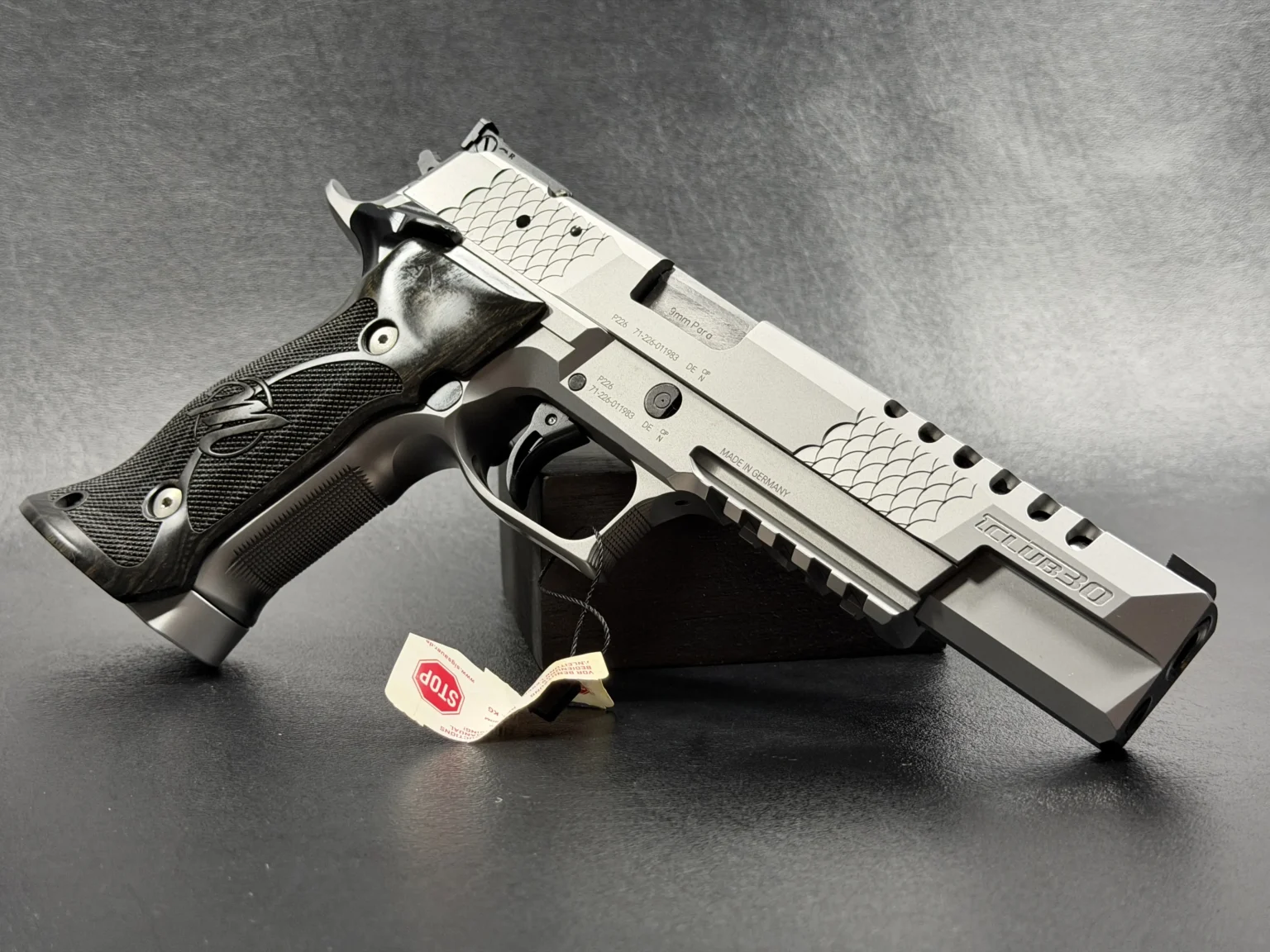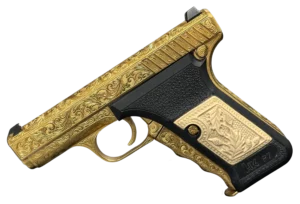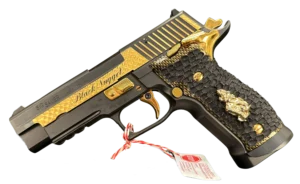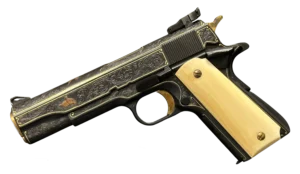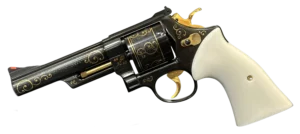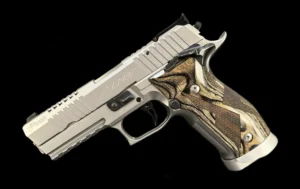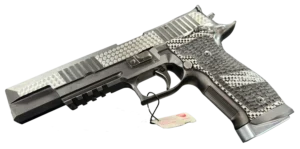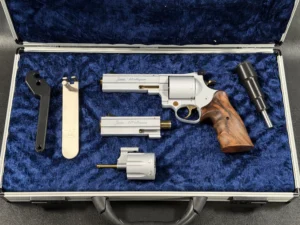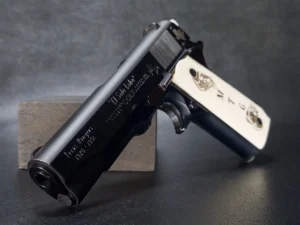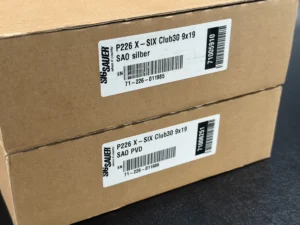Key Takeaways:
- Club 30 isn’t a factory; it’s a fellowship of gunsmiths. Born in Germany in the early ’90s, Club 30 is a guild-style collective of certified gunsmiths dedicated to precision work, constant training, and shared standards. Each member brings their own workshop and skill set, but they all adhere to the same obsessive craftsmanship that’s become the Club’s calling card.
- Their fingerprints are all over some of the finest handguns in Europe. From meticulously tuned Smith & Wesson revolvers to custom 1911s and the famed SIG Sauer X-Series builds, Club 30 specializes in bridging competition performance and collector-grade artistry. Every trigger pull, slide cut, and polish job feels intentional because it is.
- To collectors, provenance is everything. A true Club 30 firearm carries paperwork, proof of work, and a story that connects it to the guild’s exacting standards. That documentation turns a well-made pistol into a certified piece of gunsmithing heritage—something that commands respect both on the range and behind glass.
Club 30 isn’t a single maker, a product line, or a factory SKU; it’s an association: a club of highly skilled German gunsmiths who pool expertise, standards, and reputations to produce premium-tuned pistols and revolvers for competition shooters and collectors. Founded from a training course idea in the early 1990s, Club 30 was built on the principle that a small group of qualified, continually trained gunsmiths could offer a consistent, high level of craftsmanship and tuning that goes beyond routine factory work. They present themselves as a vetted guild: members must meet quality standards and participate in ongoing training and action days.
Origins & Philosophy
The origin story is straightforward and practical: during a Smith & Wesson training course in 1992, a group of German gunsmiths decided to form a selective association focused on handguns, particularly sporting handguns. The idea was to limit membership to gunsmiths with proven skill and then keep those members sharp through regular continuing education and collaborative events. Over the years, that structure allowed Club 30 to develop both technical depth (trigger tuning, barrel and frame work, sight setup) and a reputation for boutique builds that toggle between “match-ready tool” and “collectible object.” This roots-and-training origin explains why their offerings feel less like one-off hobby projects and more like a professional gunsmithing standard.
What Club 30 actually does, services & specialties
Club 30 members do a handful of tightly focused things exceptionally well:
• Precision tuning and match conversions, they convert standard handguns into all-steel, match-grade pistols (barrel fitment, action work, SAO / single-action conversions, or trigger polishing, adjustable trigger stops).
• Custom revolver builds, Club 30 has a deep history of high-end Smith & Wesson revolver conversions (underlugs, target barrels, skeletonized hammers/triggers, target sights).
• Cosmetic and ergonomic upgrades, sculpted or vented slides, distinctive dust-cover bevels, upgraded sight systems, custom grip,s and boutique finishes (PVD, color hardening, selective polishing).
• Small limited series & anniversary editions, when Club 30 releases a special model, it’s often a tightly limited run (examples and dealer notes show small series counts).
• Training & quality assurance, because the group is explicitly about continuous training, Club 30 also runs action days and events to standardize performance and share best practices among members.
Those activities explain why you’ll see Club 30 guns described as both “tuned competition pistols” and “handmade revolvers” in the same breath; they occupy the overlap between performance and bespoke finish work.
Firearms Club 30 is known for working on
Historically and today, Club 30’s most visible work falls into a few categories:
- Smith & Wesson revolvers were where Club 30 built much of its early reputation. Their revolver conversions and target revolvers (full underlug barrels, adjustable target sights, trigger/hammer skeletonization, and target tuning) are well documented in European dealers’ inventories and on Club 30 product pages. These are often presented as premium sporting revolvers made for competition and collectors.
- 1911-style pistols and custom 1911 builds, some members and partner dealers offer Club 30-branded 1911 variants and tuned versions of classic designs, usually with Club 30’s emphasis on ergonomics, match triggers, and target sights. The product listings for Club 30 1911 variants show the group’s willingness to apply their tuning philosophy to non-revolver platforms as well.
- SIG Sauer X-Series / P226 family, more recently, Club 30 has turned attention to the SIG P226 X-Series platform (X-Five, X-Six, X-Six Club30 variants and related Mastershop pieces). The X-Series provides a solid all-steel starting point for Club 30’s match-grade modifications, longer barrels, SAO triggers, sculpted/vented slides, upgraded sights, and a distinctive dustcover/bevel treatment that dealers sometimes label “Club 30.” These Club-branded SIGs are typically offered in limited numbers through specialty dealers and sometimes through SIG Mastershop inventories or Mastershop-sourced frames that then receive Club-style tuning and finishing.
- Limited-edition and anniversary models, Club 30 occasionally produces special runs (for example, a 30-piece anniversary edition tied to the organization’s milestone), further cementing its status as a boutique, collectible producer in the European market.
Who Club 30 works with, partners, importers, and channels
Club 30 operates like a vetted guild, with members collaborating with European dealers, specialty shops, and sometimes larger OEM custom divisions (for example, SIG Mastershop listings that feature Club-tuned offerings in dealer catalogs). That means Club 30 pieces frequently show up in the catalogs of high-end European arms dealers and on specialty U.S. importer listings, often described as “Club 30-converted” or “Club30 X-Six.” Dealers and auction houses usually note the Club30 provenance, and importers handle the paperwork needed to bring these limited pieces into the U.S. market. Community discussions on SIG-focused forums and auction results also reveal private orders and custom builds commissioned through Club30 members.
Why collectors and competition shooters care
A few practical reasons:
- Proven workmanship: Club 30’s membership model means buyers aren’t betting on one anonymous gunsmith; they’re buying into a vetted standard. That matters when you’re paying a premium for fit, finish, and reliability.
- Performance upgrades out of the box: a Club 30 SIG X-Series or tuned Smith & Wesson can arrive ready for competition with a light, crisp trigger, tighter barrel lockup, and improved sights — saving a buyer months of gunsmithing.
- Limited numbers & provenance: limited runs, anniversary editions, and documented conversions give certain pieces collectible cachet that can hold value (or at least create a niche desirability among European collectors and American import buyers).
What to verify when buying a Club 30 gun
Because Club 30 is an association (not a single factory), provenance and documentation are everything. If you’re buying a Club 30 piece, ask for:
- Builder/dealer paperwork: invoices or builder letters naming the Club 30 gunsmith or a specific member who did the work. Dealers who import Club-branded pistols usually include this in the sale catalog.
- A clear parts list: what was changed (barrel, trigger, slide work, sights, grips)? This tells you what spare parts will work and what a gunsmith will need if future servicing is required.
- Service history and warranty notes: Who in your country can service Club-mod work? Some modifications may require an experienced gunsmith familiar with Club30 practices.
- Import stamps and legal paperwork: especially important for U.S. buyers: confirm the import paperwork and ensure the serial/record matches the seller’s claims.
Market & resale realities
Club 30 pieces can command prices above comparable factory models, not because they’re always objectively better for every shooter, but because they combine limited availability with high-level gunsmithing and boutique finishes. That means resale depends heavily on condition, documentation, and whether the market recognizes the specific member/builder who did the work. Auction results and dealer listings show substantial variance in realized prices; provenance tightens the spread.
Final takeaways
Club 30 occupies a precise niche: it’s a collective of experienced gunsmiths who apply competition-grade tuning and boutique finishing to both classic revolvers and modern pistol platforms (particularly the SIG X-Series). The group’s strength is its membership model, quality standards, ongoing training, and collaborative credibility, which allows buyers to expect a consistent level of gunsmithing even though individual builds vary by gunsmith and project. For collectors and shooters who want an out-of-the-box match pistol or a bespoke revolver with documented provenance, Club 30 pieces are worth a close look, but only if the seller can prove who did what, and when. If you’re listing one, highlight the Club30 provenance, detail the exact modifications, and include any builder/import paperwork; those three things are the difference between “interesting custom” and “documented collectible.
Frequently Asked Questions
Club 30 is a German association of master gunsmiths founded in the early 1990s. It’s not a factory or a brand in the usual sense, but a guild, a network of qualified professionals who share training, standards, and techniques to produce high-end, custom-tuned firearms. Think of it as a seal of craftsmanship rather than a manufacturer’s logo.
The story begins in 1992, during a Smith & Wesson training course in Germany. A handful of talented gunsmiths realized there was power in collaboration. They formed “Club 30” as a platform for continuous education, the sharing of expertise, and the pursuit of match-grade perfection in revolvers and semi-automatic pistols.
Originally, Club 30 was best known for precision-tuned Smith & Wesson revolvers. Over time, members expanded their focus to include 1911-style pistols and SIG Sauer’s X-Series, especially the P226 X-Five and X-Six. These guns often feature hand-tuned triggers, polished internals, slide and barrel work, and custom finishes that elevate them beyond standard production models.
Not exactly. Club 30 guns typically start as factory-produced pistols or revolvers, which are then enhanced by Club 30 member workshops. The work can include precision fitting, cosmetic engraving, match trigger tuning, or complete conversions. In that sense, Club 30 acts as a bridge between the factory and the fully custom world.
Authentic Club 30 firearms are accompanied by documentation, builder certificates, invoices, or import papers that identify the gunsmith or workshop responsible. Some also bear subtle markings or engraving referencing the Club. Without that paperwork, it’s just a nice custom gun, not a certified Club 30 piece.
Because they blend rarity, performance, and pedigree, each build reflects the touch of an individual gunsmith working under shared guild standards, and many are produced in minimal numbers. The combination of match-grade function and handcrafted finish gives them both shooter’s appeal and collector value.


